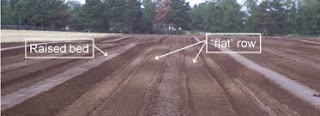Nursery bed is
defined as ‘prepared area in a nursery where seed is sown or into which
transplants or cuttings are put. Nursery beds are classified into
seedling beds and transplant beds. Similarly, considering the nature of
lands, there may two kinds of beds. They are:
It varies from locality to locality. Generally beds are 1-1.2m wide but sometimes, they are even kept upto 1.8m wide locally. This depends on seed beds, either stand out beds for polypots or beds for raising stumps or bare-rooted plants. Length of the beds is not important, though 5-10m must be convenient. If possible the beds should be oriented from east to west to provide better shade against the mid-day sun and not more than 50 . Seed beds and stand-out beds should be provided with frames on which shade can be placed; whether this is needed for beds for stumps or transplants depending on the species being raised. There should be 50-60cm wide between beds and the surrounding fence. This means that on terraced land, the terraces should be at least 2m wide.
Soil Preparation
After demarcation, the are dug in depth of 0.3-0.45m so that stone, roots, etc lying underneath are all dug out, picked and thrown outside the nursery. If the soil is gravelly, it should be sieved through a fine wire netting to remove gravels. Then, soil should be mixed with farmyard manure. At the same time, charcoal dust and ashes are also mixed to correct the acidity of soil and keep away worms. If there is a danger of white ant attack, Aldrex 5% dust should be mixed @ 75kg/ha.
In the hills, new terraces have to be built with the help of string and pegs, and the drainage network should be planned. the top-soil should be first removed carefully from the surface of the terrace and put in a pile, and after the terrace has been made it should be replaced on the terrace surface.
In general, the surface of the beds should be either flat or preferrably be given a slight camber. If the soil is heavy, a top dressing of washed river sand is usually given, which prevent to cake the watered beds and no splash during rains. Burning of dry grass and shrubs piled on beds reduces weed growth and is very beneficial for species having minute seeds eg. Adina cordinfolia.
- Sunken beds: In areas with long dry hot weather, beds are kept slightly below the general ground level. Such beds can be easily irrigated, during dry season. This type of beds are used for raising stock through vegetative propagation like cutting of popular, sissoo, mulberry, willows, and bamboos off sets. Besides these Acacia nilotica, A. benthenwii, Prosopisjuli flora etc.
- Raised beds: In moister areas, nursery beds are raised 10-15cm above the level of the grounds, which can be supported either by bamboos or line of bricks, stones, etc. This prevents their edges from being eroded away during the rainy season or by irrigation or outside water from seeping into the bed. The species which are commonly raised on beds are Deodar, Kail, Spruce, Fir, Robinia, Walnut, Bird cherry, Ash etc.
- Level beds: Level beds are commonly used for raising seedlings of Tuni, Eucalyptus, Ritha, Terminalia, Siris, Grevillia, etc. These species cannot tolerate standing water, their water requirement is also moderate.
It varies from locality to locality. Generally beds are 1-1.2m wide but sometimes, they are even kept upto 1.8m wide locally. This depends on seed beds, either stand out beds for polypots or beds for raising stumps or bare-rooted plants. Length of the beds is not important, though 5-10m must be convenient. If possible the beds should be oriented from east to west to provide better shade against the mid-day sun and not more than 50 . Seed beds and stand-out beds should be provided with frames on which shade can be placed; whether this is needed for beds for stumps or transplants depending on the species being raised. There should be 50-60cm wide between beds and the surrounding fence. This means that on terraced land, the terraces should be at least 2m wide.
Soil Preparation
After demarcation, the are dug in depth of 0.3-0.45m so that stone, roots, etc lying underneath are all dug out, picked and thrown outside the nursery. If the soil is gravelly, it should be sieved through a fine wire netting to remove gravels. Then, soil should be mixed with farmyard manure. At the same time, charcoal dust and ashes are also mixed to correct the acidity of soil and keep away worms. If there is a danger of white ant attack, Aldrex 5% dust should be mixed @ 75kg/ha.
In the hills, new terraces have to be built with the help of string and pegs, and the drainage network should be planned. the top-soil should be first removed carefully from the surface of the terrace and put in a pile, and after the terrace has been made it should be replaced on the terrace surface.
In general, the surface of the beds should be either flat or preferrably be given a slight camber. If the soil is heavy, a top dressing of washed river sand is usually given, which prevent to cake the watered beds and no splash during rains. Burning of dry grass and shrubs piled on beds reduces weed growth and is very beneficial for species having minute seeds eg. Adina cordinfolia.

No comments:
Post a Comment